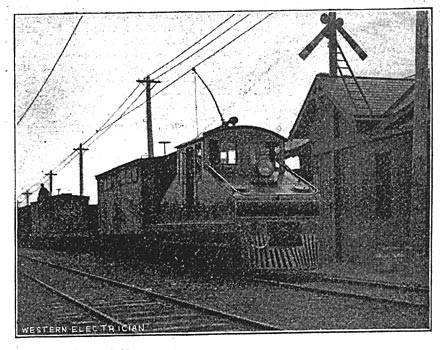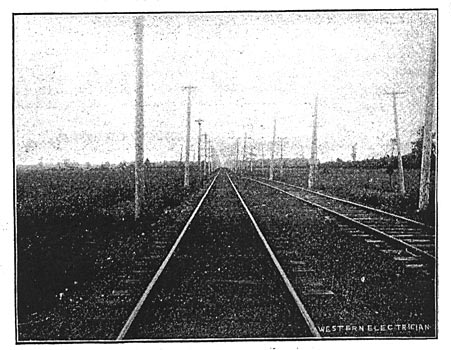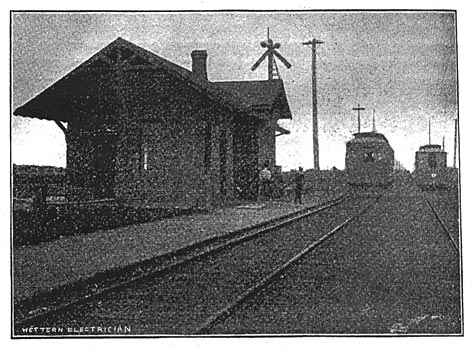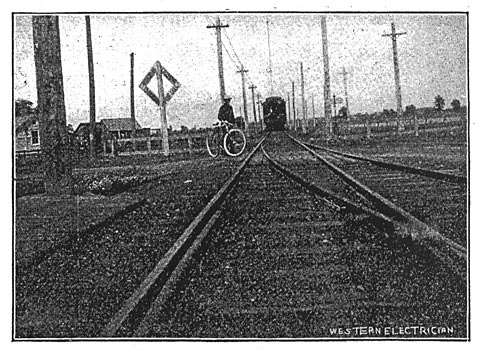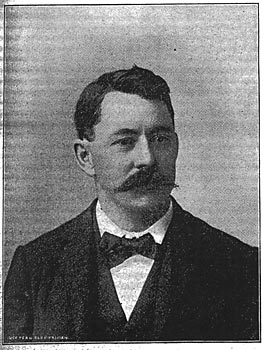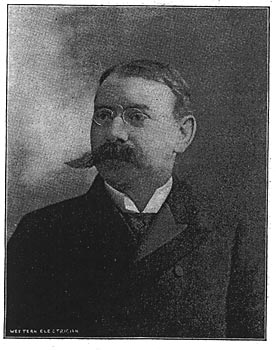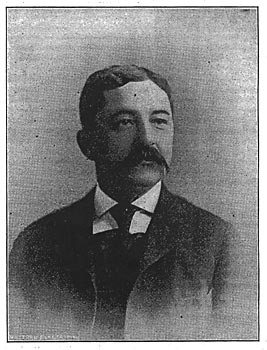[Trade Journal]
Publication: Western Electrician
Chicago, IL, United States
vol. 23, no. 10, p. 130-131, col. 1-3
Steam Locomotives Supplanted by
Electric Trolley.
BY ORRIN E. DUNLAP.
The Buffalo and Lockport Railway cornpany has placed its new line connecting the county seats of Erie and Niagara counties in operation. The completion of the road marks a significant advancement of electricity in a field heretofore occupied by steam power. From Buffalo to North Tonawanda the cars of the Buffalo and Lockport line at present use the tracks of the Buffalo and Niagara Falls Railway company, but in the future it is expected that an independent connection will be established with Buffalo, possibly creating a belt line. From North Tonawanda to Lockport the Buffalo-Lockport cars are run over the old Tonawanda-Lockport branch of the Erie railroad. This branch has been leased by the Buffalo and Lockport Railway company, and the line fitted for electric service. On taking possession the Buffalo and Lockport Railway company found the track in fair condition. The rails used by the Erie company were of the 60-pound type, and about two miles out of Lockport a mile of track was relaid with 80-pound rails.
| |||
| Fig. 1. Steam Locomotives Supplanted by Electric Trolley. — Transformer Room in Lockport, Showing Rotary Converter, Static Transformers and Switchboard. |
The contractors in charge of the reconstruction of the line were J. G. White & Co., and they had as their superintendent John A. Wilson. Quick work was necessary, and Mr. Wilson was especially fitted for the task, as he had had considerable experience in construction in the Niagara locality, having built the Buffalo and Niagara Falls electric road and the Buffalo-Niagara power-transmission line. The road from North Tonawanda to Lockport is a single track. At present it has three switches or turn-outs, and it is. possible that more will be placed. One of these turnouts is a mile west of Lockport, another six miles and the third 10 miles. In bonding the track two gangs were employed, one working days and the other; nights. About 20 days was occupied in bonding the track, a three-inch horse-shoe bond with 0000 wire being used underneath the rail. The trolley wire is put up with a double line of poles set 88 feet apart, excepting for about three-quarters of a mile in North Tonawanda, where an arm support is used. Along the poles on the north side of the track two 5,000,000 circular-mil feeder cables are strung, while on the south side of the right-of-way a power transmission line has been built. This transmission line taps the Buffalo-Niagara Falls power transmission line at North Tonawanda.
| |||
| Fig. 2. Steam Locomotives Supplanted by Electric Trolley. — Switchboards of the Lockport Transformer Station. |
The poles are set 100 feet apart and on the single crossarm three 0000 wires are strung. The insulators used are the same as those employed on the Buffalo-Niagara Falls transmission line. The tops of all the poles are 22 feet above the rail. In erecting the wires a construction train was employed consisting of three flat-cars, a caboose and an engine. A six horse power hoisting engine was located on one of the flats to aid in picking up-and raising the poles. In stringing the wire the train was kept in motion and the wire was laid from a boom on one of the cars across the poles, about five miles of wire being run out each day. The plan of the company is to feed the Lockport end from the Lockport transformer station, and the Tonawanda end from a transformer station there. In leasing the Erie branch the Buffalo and Lockport Railway company secures possession of the neat and commodious stations along the line, and in the rear of the Lockport depot it has erected a spacious car-storage barn, transformer room and workshop. This building is of brick and has a steel truss roof. In the transformer room a view of which is presented in Fig. 1, two 500 horse power rotary converters have been installed, together with the necessary static transformers and switchboards. Fig. 2 shows the switchboards.
| |||
| Fig. 3. Electric Locomotive in Use on the Buffalo and Lockport Line. Steam Locomotives Supplanted by Electric Trolley. |
| |||
| Fig. 4. "For 10 Miles or More the Track is As Straight As the Flight of An Arrow." Steam Locomotives Supplanted by Electric Trolley. |
| |||
| Fig. 5. Cars Passing at Pendleton Centre. Steam Locomotives Supplanted by Electric Trolley. |
| |||
| Fig. 6. "Good-Bye, Old Erie." One of the Last Trains Over the Line. Steam Locomotives Supplanted by Electric Trolley. |
The length of the route from Lockport to Buffalo is about ,25 miles. The distance from North Tonawanda to Lockport is about 13 miles, and for over 10 miles of this distance the road is as straight as the flight of an arrow, a fact which will allow exceptionally good time to be made. This part of the road is shown in Fig. 4. The transportation equipment of the road consists of 16 cars, two of them being combination baggage and passenger and eight being combination smokers. Each car is fitted with four GE 57 motors, having a rated capacity of 52 horse power, thus giving each car 52 horse power. The cars were made by the Brill company of Philadelphia, and in color resemble the "yellow fellows" of the Buffalo and Niagara Falls road. They are very large and apparently well fitted for the service they were built to perform. In addition to the cars the company has purchased two General Electric locomotives, each of which weighs 45 tons and has four No. 55 motors. They have a guaranteed speed of 15 miles an hour, and they have been known to draw 28 loaded cars with good results. It is a fact worth noting that this type of locomotive (Fig. 3) is the same as will be employed on the underground roads in London, England, To the Buffalo and Lockport Railway company the use of these locomotives is destined to be especially valuable, from the fact that the company already has a large, freight business from Lockport to North Tonawanda. Succeeding, as it did, the full train service of the Erie road between these two points, a heavy freight business fell to it to care for, and it was deemed necessary to place in early order for these locomotives. Still another feature of importance is the fact that the Buffalo and Lockport Railway company owns and controls the Lock City road, and under the franchise has the right to haul freight through the streets of Lockport between the hours of 11 p. m. and 5 a. m. Lockport is a manufacturing city of some magnitude, and, as the tracks of the local company run to the mills, considerable freight is obtained, which is turned over to the Erie at North Tonawanda. It is also a great convenience on special occasions. In a recent case, when the firemen of Lockport were going on an excursion, a sleeping coach and a car of the Erie were run to Lockport, which the firemen boarded, and were drawn by one of the electric locomotives to North Tonawanda, where connection was made with the Erie passenger train, thus saving the annoyance of transferring.
There is every probability that the Buffalo and Lockport company will very early extend the line to Olcott on Lake Ontario, passing a rich farming country, from which much freight is likely to be secured. Other possibilities of profitable patronage open before the road to lead the company to extend it eastward toward the city of Rochester. Between Lockport and Rochester there are many well-populated, busy, thriving villages that would welcome the entrance of a trunk-line electric road to their boundaries. The country through which the line runs from North Tonawanda to Lockport is well settled, and it may be said that the farmers living along the line welcome the advent of the trolley. One important reason for this is that with the passing of the steam locomotive from the tracks the danger of fire from flying, sparks among their crops is materially lessened. The train service of the Erie consisted of four passenger trains each way on week days and one freight. It is the intention of the Buffalo and Lockport Railway company to give a half-hour service between Buffalo and Lockport, which materially increases the accomodations of the line for passenger traffic to the county seats in Erie and Niagara and intervening points. The time consumed in making the run from Buffalo to Lockport is a little over an hour, and about the same time is made between Niagara Falls and Lockport, a change of cars being at present made in North Tonawanda.
| |||
| John A. Wilson. |
In constructing the Buffalo-Niagara power-transmission line the Niagara Falls Power company purchased a strip of land 30 feet wide for a greater part of the distance. In the case of the transmission of Niagara power to Lockport, the route of the new electric line is sufficiently wide to allow a substantial portion of it to be used for power-transmission purposes, and the taking of Niagara power to Lockport for the operation of this new trolley line may be the means of considerable Niagara power being transmitted to the Lock City for use in the manufacturing plants there. Lockport is not well provided at present with power facilities, and it would certainly welcome such a substantial addition to its force as a portion of the product of the great dynamos of Niagara.
The president of the Buffalo and Lockport Railway company is the Hon. W. Caryl Ely of Niagara Falls. Mr. Ely is also president of the Buffalo and Niagara Falls Electric Railway company, and last year he was honored by election as first vice-president of the American Street Railway association. Mr. Ely is an attorney who has been attracted to street-railway construction by the possibilities he saw in the construction of rapid-running roads through sections of country bordering on such cities as Niagara Falls, Buffalo and Lockport. He has always been much interested in the electrical development in and about Niagara, and has organized many successful companies. He was born in Middlefield, N. Y., February 25, 1856. His education was obtained in Cooperstown, N. Y., Girard, Pa., Franklin, N. Y., and Cornell University. In 1882 he was admitted to the bar, and in 1883-85 was a member of the New York State Assembly. His residence at Niagara Falls dates back to 1885. Mr. Ely's success at Niagara has been phenomenal, and Niagara won much by his selecting it as a place of residence and business. In his profession Mr. Ely has a very high standing. His ability, tact and integrity will do much for the advancement of electric-railway interests.
| |||
| W. Caryl Ely. |
The general manager of the Buffalo and Lockport company is Burt Van Horn, who also holds a similar position on the Buffalo and Niagara Falls road. Mr. Van Horn was born in Niagara County and was educated in the Lockport schools. He graduated from the Columbia Law School in 1878 and was admitted to the bar in the same year. Mr. Van Horn was one of the promoters of the Buffalo and Niagara Falls road, and as he knows quite well the transportation facilities needed in Lockport, the people of that city are well pleased to know that he will look after their welfare in this respect. Mr. Van Horn is an active man and is well qualified to manage such properties as those with which he is connected in western New York.
| |||
| Burt Van Horn. |
The superintendent of the new line is C. K. Marshall, who was born in Niagara Falls. He is superintendent of the Buffalo and Niagara Falls road, and is. noted for getting his cars through on time. From this review of the officers of the Buffalo and Lockport Railway company it will be seen that its interests are closely allied to those of the Buffalo and Niagara Falls Electric Railway company. The success that road has met has portrayed the energy of the men behind it, and this energy will now be devoted to developing the resources of the two electric roads.
The Buffalo, Kenmore and Tonawanda electric railway has been sold to Attorney Morris Cohn for $63,147.32, the amount of the first-mortgage bonds held by him, and with the understanding that he shall satisfy a claim of $28,000 held by the assignees. This will make the sale price about $91,147,32. The sale was made by the referee, Frederick Chormann of Niagara Falls, as the result of a foreclosure action brought by the Fidelity Trust and Guaranty company as trustee for the bondholders. The sale began Monday morning, August 22d, and was twice postponed to give Fred and Charles Gay of New York, who bid $95,000, opportunity to make a deposit of $3,000, required by the terms of the sale from the highest bidder. On Tuesday, August 23d, the sale was made to Mr. Cohn. It is said that this road has never paid running expenses. It comprises about five miles of track and roadbed, a power house, four cars and a small piece of real estate. Mr. Cohn, the purchaser, is a member of the law firm of Ely, Dudley & Cohn of Niagara Falls. It is stated that the road will be made a portion of the Buffalo and Lockport Railway company's system, and that it will be utilized to enter the city of Buffalo independently of the tracks of the Buffalo and Niagara Falls road. It may be made a portion 'of a belt line around Buffalo.



